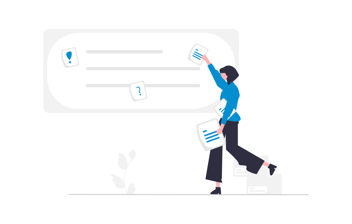What's your Customer Effort Score (CES)?
As businesses try to understand their customers better, there are more and more ways to ask for and assess their feedback.
For over 20 years, Net Promoter Scores (NPS) were the metric of choice but recently, brands have been looking for more. While NPS surveys give a generalised indication of customer satisfaction, they don’t get to the core of the matter. That’s where Customer Effort Scores come in.
What is a Customer Effort Score?
Customer effort scores (CES) measure how easy it is for a customer to get what they want from a business, product, or service and is usually on a scale of 1-5. These responses are highly valuable because they give insight into the Customer Experience and what could be improved.
CES surveys can ask how much effort was required to use:
- Customer support.
- A product or service.
- The brand website or app.
- The transaction method, online or in person.
- The brand’s communication channels.
Essentially, the least amount of effort a customer exerts, the better. If an interaction is too difficult for them, they’re likely to give up and find what they’re looking for elsewhere.
How to calculate your Customer Effort Score
Unlike most customer feedback metrics, the best CES scores are low. The score is reflective of the effort customers have to put in, so the lower their score, the happier they’ll be.
To calculate your CES, all you need to do is divide the sum of all the scores by the total number of responses. This will give you an average.

The lower the average, the easier it is for your customers to interact with your brand. If your score is higher, you will need to take a closer look at the Customer Experience. Once you make some positive changes, your average should get lower.
How important is a Customer Effort Score?
In a world where everything is available at the click of a button, consumers have become accustomed to getting what they need quickly and easily. To meet those expectations, brands need to ensure their processes are as seamless and intuitive as possible.
If a customer comes up against any unnecessary challenges when interacting with a brand, they’re not likely to stick around. To avoid that, businesses need a way to identify and assess those obstacles before they become major problems.
Customer Effort Scores help to highlight:
- Problems with products.
- Technological breakdowns or glitches.
- Sticking points on the website or app.
- Gaps in the customer support team.
Making informed decisions
Checking in with customers allows you to get your information straight from the source, meaning the decisions and improvements you make are relevant and effective. Whether those changes are major overhauls or fine-tuned details, they all make a difference to your customer loyalty.
Targeting problems early
CES scores can be used to measure specific parts of the customer journey, not just the overall experience. This means you can track how each sector of your brand is performing and get to the bottom of issues sooner.
For example, if a customer gives a low score for app navigation and a high score for customer support, it’s easy for the brand to target the real problem. Instead of making a wild guess, they can immediately get to work on their app and reward the customer support team for a job well done.
How to improve your Customer Effort Score
When implementing Customer Effort Scores, there are several key things to remember. To get the best results from your CES data, you need to:
- Please limit your survey to 1 or 2 questions.
- Ensure questions are specific and clear.
- Collate all the information in one place.
- Analyse the data to spot trends.
- Use a consistent scale, like 1-5.
Customer Effort Score questions
The best Customer Effort Score questions are quantifiable, simple, and specific. The format can be either a sliding scale, a drop-down of answers, or a set of draggable options to rank in order.
To help you get started, here are some popular examples:
- How easy was it to get the help you needed from our team?
- How easy was it to find the product you wanted?
- How easy was it to use this product?
- How easy was it to get in touch with our team?
When to use a Customer Effort Score survey
CES Surveys are incredibly helpful, but there are a few times you shouldn’t use them. For example, if a customer is experiencing frustrating delays or struggling to find the answers they need, sending them a survey link will make the situation worse.
The goal of a CES survey is to improve the Customer Experience, so be sure to send them when customers have the time and mindset to respond. Examples include:
After a purchase or subscription
If a customer has just invested in your brand, they should be feeling excited, satisfied, or inspired. Not only will response rates be higher, but the responses will also give valuable insight into the transaction process.
To target these customers, simply incorporate a survey request link into the order confirmation email. This way, the customer doesn’t feel spammed and is more likely to click on the email in the first place.
After a customer service experience
When a customer interacts with customer service, they should come away from it feeling satisfied, heard, and understood. By targeting them at that moment, you can ensure the insights are timely, relevant, and specific to the customer service team.
All you need to do is add a CES survey request at certain customer service touchpoints. For example, a link in an email support ticket or a QR code at the customer service desk.
To supplement UI and UX testing
When product teams are testing for User Interface (UI) and User Experience (UX), a Customer Effort Score can help to highlight the strengths and weaknesses of the design. Instead of guessing what customers will think, a CES survey gives the answers directly.
As more businesses are becoming attentive to their customer's expectations, you should be tuning in to yours. By engaging with customer feedback and the various metrics, tools, and platforms available, you can find out how to stand out among your competitors.
Learn more about how to get started by downloading our helpful guide on customer feedback strategies.



